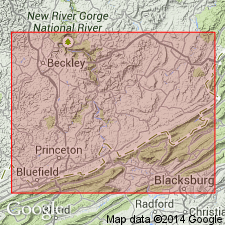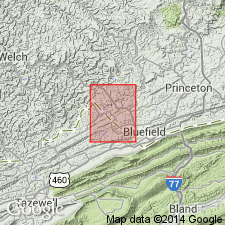
- Usage in publication:
-
- Hackett sandstone [member]
- Modifications:
-
- Named
- Dominant lithology:
-
- Sandstone
- Shale
- AAPG geologic province:
-
- Appalachian basin
Summary:
Named the Hackett sandstone [member] in the Hinton formation for Hackett Creek, near Pettry, Mercer Co., southeastern WV. Consists of greenish gray, sometimes massive, but often made up of thick hard flags separated by streaks of shale. Thickness is 10 to 75 feet. Overlies the Hackett shale [member] and underlies the Payne Branch shale [member] both of Hinton formation. The Hackett is of Mississippian age.
Source: GNU records (USGS DDS-6; Reston GNULEX).

- Usage in publication:
-
- Hackett Sandstone Member*
- Modifications:
-
- Overview
- AAPG geologic province:
-
- Appalachian basin
Summary:
The Hackett Sandstone Member of the Hinton Formation in southeastern WV consists of fine- to medium-grained, thick-bedded sandstone that contains lenses of limestone, ironstone, and shale pebbles. Thickness is 0 to 50 feet. The Hackett is of Late Mississippian age.
Source: GNU records (USGS DDS-6; Reston GNULEX).
For more information, please contact Nancy Stamm, Geologic Names Committee Secretary.
Asterisk (*) indicates published by U.S. Geological Survey authors.
"No current usage" (†) implies that a name has been abandoned or has fallen into disuse. Former usage and, if known, replacement name given in parentheses ( ).
Slash (/) indicates name conflicts with nomenclatural guidelines (CSN, 1933; ACSN, 1961, 1970; NACSN, 1983, 2005, 2021). May be explained within brackets ([ ]).

